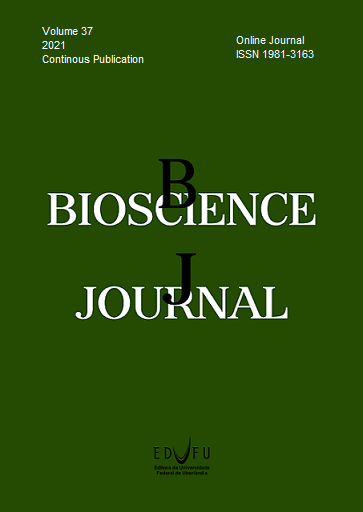Use of the imazapic herbicide applied alone or tank mix with imazapyr as growth regulator of lawns
DOI:
https://doi.org/10.14393/BJ-v37n0a2021-53642Keywords:
Imidazolinone, Paspalum notatum, Plant inhibitors, Stenotaphrum secundatum.Abstract
Successive mowing are the major maintenance costs of lawns. Thus, both the expenditure with mowing and the visual and physiological aspect of the lawn have led to the search for alternatives to mechanical management. Thus, this work aimed to study the effects of different rates of imazapic herbicide applied alone or combined with imazapyr as a growth regulator of Bahiagrass (Paspalum notatum) and St. Augustine grass (Stenotaphrum secundatum). The experimental design was a randomized block with four replicates, and the treatments consisted of six rates of imazapic herbicide (35; 70; 105; 140; 175 and 210 g a.i. ha-1) for both species, three rates of imazapic + imazapyr in tank mix (15.57 + 5.25; 23.625 + 7.875; 32.5 + 10.5 g a.i. ha-1) for Bahiagrass and four rates of imazapic + imazapyr mixture (7.875 + 2.625; 15.57 + 5.25; 23.625 + 7.875; 32.5 + 10.5 g a.i. ha-1) for St. Augustine grass. The effect of the treatments was evaluated by observing visible injury symptoms, canopy height, height and number of inflorescences and total dry matter of clippings. Applications of imazapic alone or combined with imazapyr were effective in reducing plant height, number and height of inflorescences and total amount of dry matter of clippings produced by Bahiagrass plants. Imazapic provided satisfactory control of St. Augustine growth, but its utilization caused an increase in the number of inflorescences present in the lawns.
References
BAJRAI, F.S.M., et al. Persistence of imazapic and imazapyr in paddy soil and water. International Journal of Advances in Agricultural & Environmental Engineering. 2017, 4(1), 12-15. https://doi.org/10.15242/IJAAEE.EAP117210
BARBOSA, J.C. and MALDONADO JR., W. Experimentação agronômica & AgroEstat: Sistemas para análises estatísticas e ensaios agronômicos. Jaboticabal: Gráfica Multipress Ltda, 2015.
BARBOSA, A.P., et al. Paspalum notatum growth and pigment content in response to the application of herbicides. Revista Brasileira de Herbicidas. 2017, 16(2), 142-151. http://dx.doi.org/10.7824/rbh.v16i2.520
BRIGHENTI, A.M., BENITES, F.R.G. and SOBRINHO, F.S. African star grass response to postemergence herbicides. Ciência e Agrotecnologia. 2019, 43, e026918. https://doi.org/10.1590/1413-7054201943026918
BRITO, I.P., et al. Hormetic effects of glyphosate on plants. Pest management science. 2018, 74(5), 1064-1070. https://doi.org/10.1002/ps.4523
COAN, R.M., et al. Emerald zoyzia grass development regarding photosynthetically active radiation in different slopes. Engenharia Agrícola. 2012, 32, 501-509. http://dx.doi.org/10.1590/S0100-69162012000300009
COSTA, N.V., et al. Seletividade de herbicidas aplicados na grama Batatais e na grama São Carlos. Planta Daninha. 2010, 28(2), 365-374. https://doi.org/10.1590/S0100-83582010000200016
CUNHA, A.R. and MARTINS, D. Classificação climática para os municípios de Botucatu e São Manuel, SP. Irriga. 2009, 14(1), 1-11. https://doi.org/10.15809/irriga.2009v14n1p1-11
EMBRAPA - Empresa Brasileira de Pesquisa Agropecuária. Sistema brasileiro de classificação de solos. Brasília: Embrapa Informação Tecnológica, 2006.
GATES, R.N., QUARIN, C.L. and PEDREIRA, C.G.S. Bahiagrass. In: MOSER, L.E., BURSON, B.L. and SOLLENBERGER, L.E. (Eds.). Warmseason (C4) grasses. Madison: WI: ASA, CSSA and SSSA, 2004. pp.651-680. https://doi.org/10.2134/agronmonogr45.c19
JOHNSON, B.J. Influence of frequency and dates of plant growth regulator applications to centipedegrass on seedhead formation and turf quality. HortScience. 1990, 115(3), 412-416. https://doi.org/10.21273/JASHS.115.3.412
KÖPPEN, W. Climatologia. Buenos Aires: Gráfica Panamericana, 1948.
LI, X., et al. Effects of Bahia grass cover and mulch on runoff and sediment yield of sloping red soil in Southern China. Pedosphere. 2011, 21(2), 238-243. https://doi.org/10.1016/S1002-0160(11)60123-9
MACIEL, C.D.G., et al. Desenvolvimento de gramados submetidos à aplicação de retardadores de crescimento em diferentes condições de luminosidade. Planta Daninha. 2011, 29(2), 383-395. https://doi.org/10.1590/S0100-83582011000200016
MACIEL, C.D.G., et al. Seletividade e eficácia dos herbicidas Kapina® e Kapina Plus® no controle de tiririca em gramas bermuda e esmeralda. Revista Brasileira de Herbicidas. 2013, 12(1), 39-46. https://doi.org/10.7824/rbh.v12i1.234
MARCHI, S.R., et al. Effect of plant regulators on growth and flowering of Meyer' zoysiagrass. Planta Daninha. 2013, 31(3), 695-703. https://doi.org/10.1590/S0100-83582013000300021
MARCHI, S.R., MARTINS, D. and COSTA, N.V. Tifton 419' Bermudagrass ('Cynodon dactylon x C. transvaaliensis') response to plant grow inhibitors. Australian Journal of Crop Science. 2014, 8(11), 1481-1486. www.cropj.com/marchi_8_11_2014_1481_1486.pdf
MARCHI, S.R., MARTINS, D. and COSTA, N.V. Effects of plant regulators on the growth and flowering of Saint Augustine grass plants. Bioscience Journal. 2015, 31(3), 785-793. https://doi.org/10.14393/BJ-v31n3a2015-26093
MARCHI, S.R., MARTINS, D. and COSTA, N.V. Growth and flowering inhibition of Paspalum notatum with application of trinexapac-ethyl and prohexadione-calcium. Revista Brasileira de Engenharia Agrícola e Ambiental. 2016, 20(3), 202-208. https://doi.org/10.1590/1807-1929/agriambi.v20n3p202-208
MARCH, S.R, MARTINS, D. and McELROY, J.S. Growth inhibitors in turfgrass. Planta Daninha. 2013, 31, 733-47. https://doi.org/10.1590/S0100-83582013000300025
MARINHO, M.I.C., et al. Sorption-Desorption Behavior of Imazethapyr and Imazapic on Six Brazilian Soils. Planta Daninha. 2018, 36, e018177486. https://doi.org/10.1590/s0100-83582018360100140
MATTE, W.D., et al. Residual Activity of [imazapic+ imazapyr] Applied to Imidazolinones Resistant Soybean on Cotton in Succession. Planta Daninha. 2018, 36, e018181240. https://doi.org/10.1590/s0100-83582018360100148
MCCARTY, L.B. ‘Ttifeagle’ bermudagrass response to plant growth regulators and mowing height. Agronomy Journal. 2011, 103, 988-994. http://dx.doi.org/10.2134/agronj2010.0467
PIVETA, L.B., et al. Selectivity of imazapic+ imazapyr herbicides on irrigated rice as affected by seed treatment with dietholate and clomazone applied in preemergence. Planta Daninha. 2018, 36, e018149361. https://doi.org/10.1590/s0100-83582018360100062
REFATTI, J.P., et al. Leaching and residual activity of imidazolinone herbicides in lowland soils. Ciência Rural. 2017, 47(5), e20160705. https://doi.org/10.1590/0103-8478cr20160705
KIMBALL, J.A., et al. Assessing freeze-tolerance in St. Augustinegrass: temperature response and evaluation methods. Euphytica. 2017, 213(5), 110-120. https://doi.org/10.1007/s10681-017-1899-z
RINELLA, M.J., MASTERS, R.A. and BELLOWS, S.E. Effects of growth regulator herbicide on downy brome (Bromus tectorum) seed production. Invasive plant science and management. 2013, 6(1), 60-64. https://doi.org/10.1614/IPSM-D-12-00033.1
SHANER, D.L. Herbicide Handbook. 10ª ed. Lawrence: WSSA, 2014.
SOCIEDADE BRASILEIRA DA CIÊNCIA DAS PLANTAS DANINHAS – SBCPD. Procedimentos para instalação, avaliação e análise de experimentos com herbicidas. Londrina: SBCPD, 1995.
VELINI, E.D., et al. Growth Regulation and Other Secondary Effects of Herbicides. Weed Science. 2010, 58(3), 351–354. https://doi.org/10.1614/WS-D-09-00028.1
Downloads
Published
Issue
Section
License
Copyright (c) 2021 Ricardo Fagundes Marques, Sidnei Roberto de Marchi, Dagoberto Martins

This work is licensed under a Creative Commons Attribution 4.0 International License.





